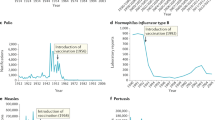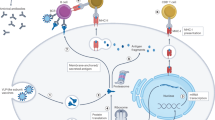Abstract
The recent influenza vaccine shortages have provided a timely reminder of the tenuous nature of the world's vaccine supply and the potential for manufacturing issues to severely disrupt vital access to important vaccines. The application of new technologies to the discovery, assessment, development and production of vaccines has the potential to prevent such occurrences and enable the introduction of new vaccines. Gene-based vaccines, virus-like particles, plant-derived vaccines and novel adjuvants and delivery systems represent promising approaches to creating safer, more potent vaccines. As a consequence, more people will have faster access to more effective vaccines against a broader spectrum of infectious diseases. However, the increased cost of producing new vaccines and regulatory uncertainty remain challenges for vaccine manufacturers.
This is a preview of subscription content, access via your institution
Access options
Subscribe to this journal
Receive 12 print issues and online access
$259.00 per year
only $21.58 per issue
Buy this article
- Purchase on SpringerLink
- Instant access to full article PDF
Prices may be subject to local taxes which are calculated during checkout


Similar content being viewed by others
References
Cooper, M.R., Stewart, D.C., Kahl, F.R., Brown, W.M. & Cordell, A.R. Medicine at the medical center then and now: one hundred years of progress. South. Med. J. 95, 1113–1121 (2002).
Sheridan, C. The business of making vaccines. Nat. Biotechnol. 23, 1359–1366 (2005).
Greco, M. Key drivers behind the development of global vaccine market. Vaccine 19, 1606–1610 (2001).
Martineau, B. Stats. Sticking with growth. Vaccine market continues to rise. Mater. Manag. Health Care 13, 42 (2004).
Rappuoli, R., Miller, H.I. & Falkow, S. Medicine. The intangible value of vaccination. Science 297, 937–939 (2002).
Farchaus, J.W., Ribot, W.J., Jendrek, S. & Little, S.F. Fermentation, purification, and characterization of protective antigen from a recombinant, a virulent strain of Bacillus anthracis. Appl. Environ. Microbiol. 64, 982–991 (1998).
Ribot, W.J. et al. Comparative vaccine efficacy of different isoforms of recombinant protective antigen against Bacillus anthracis spore challenge in rabbits. Vaccine 24, 3469–3476 (2006).
Holst, J. et al. Serum bactericidal activity correlates with the vaccine efficacy of outer membrane vesicle vaccines against Neisseria meningitidis serogroup B disease. Vaccine 21, 734–737 (2003).
Tettelin, H. et al. Complete genome sequence of Neisseria meningitidis serogroup B strain MC58. Science 287, 1809–1815 (2000).
Pizza, M. et al. Identification of vaccine candidates against serogroup B meningococcus by whole-genome sequencing. Science 287, 1816–1820 (2000).
Langermans, J.A. et al. Protection of macaques against Mycobacterium tuberculosis infection by a subunit vaccine based on a fusion protein of antigen 85B and ESAT-6. Vaccine 23, 2740–2750 (2005).
Belshe, R., Lee, M.S., Walker, R.E., Stoddard, J. & Mendelman, P.M. Safety, immunogenicity and efficacy of intranasal, live attenuated influenza vaccine. Expert Rev. Vaccines 3, 643–654 (2004).
Buonagurio, D.A. et al. Genetic stability of live, cold-adapted influenza virus components of the FluMist/CAIV-T vaccine throughout the manufacturing process. Vaccine 24, 2151–2160 (2006).
Hardy, C.T., Young, S.A., Webster, R.G., Naeve, C.W. & Owens, R.J. Egg fluids and cells of the chorioallantoic membrane of embryonated chicken eggs can select different variants of influenza A (H3N2) viruses. Virology 211, 302–306 (1995).
Katz, J.M. & Webster, R.G. Amino acid sequence identity between the HA1 of influenza A (H3N2) viruses grown in mammalian and primary chick kidney cells. J. Gen. Virol. 73, 1159–1165 (1992).
Halperin, S.A. et al. Safety and immunogenicity of a trivalent, inactivated, mammalian cell culture-derived influenza vaccine in healthy adults, seniors, and children. Vaccine 20, 1240–1247 (2002).
Nicolson, C., Major, D., Wood, J.M. & Robertson, J.S. Generation of influenza vaccine viruses on Vero cells by reverse genetics: an H5N1 candidate vaccine strain produced under a quality system. Vaccine 23, 2943–2952 (2005).
Neumann, G., Fujii, K., Kino, Y. & Kawaoka, Y. An improved reverse genetics system for influenza A virus generation and its implications for vaccine production. Proc. Natl. Acad. Sci. USA 102, 16825–16829 (2005).
Donnelly, J.J., Ulmer, J.B., Shiver, J.W. & Liu, M.A. DNA vaccines. Annu. Rev. Immunol. 15, 617–648 (1997).
Wang, R. et al. Induction of antigen-specific cytotoxic T lymphocytes in humans by a malaria DNA vaccine. Science 282, 476–480 (1998).
Rottinghaus, S.T., Poland, G.A., Jacobson, R.M., Barr, L.J. & Roy, M.J. Hepatitis B DNA vaccine induces protective antibody responses in human non-responders to conventional vaccination. Vaccine 21, 4604–4608 (2003).
McShane, H. et al. Recombinant modified vaccinia virus Ankara expressing antigen 85A boosts BCG-primed and naturally acquired antimycobacterial immunity in humans. Nat. Med. 10, 1240–1244 (2004).
Ulmer, J.B., Wahren, B. & Liu, M.A. Gene-based vaccines: recent technical and clinical advances. Trends Mol. Med. 12, 216–222 (2006).
Hoare, M. et al. Bioprocess engineering issues that would be faced in producing a DNA vaccine at up to 100 m3 fermentation scale for an influenza pandemic. Biotechnol. Prog. 21, 1577–1592 (2005).
McConkey, S.J. et al. Enhanced T-cell immunogenicity of plasmid DNA vaccines boosted by recombinant modified vaccinia virus Ankara in humans. Nat. Med. 9, 729–735 (2003).
Harper, D.M. et al. Sustained efficacy up to 4.5 years of a bivalent L1 virus-like particle vaccine against human papillomavirus types 16 and 18: follow-up from a randomised control trial. Lancet 367, 1247–1255 (2006).
Alonso, P.L. et al. Duration of protection with RTS,S/AS02A malaria vaccine in prevention of Plasmodium falciparum disease in Mozambican children: single-blind extended follow-up of a randomised controlled trial. Lancet 366, 2012–2018 (2005).
Tacket, C.O. Plant-derived vaccines against diarrheal diseases. Vaccine 23, 1866–1869 (2005).
Thanavala, Y. et al. Immunogenicity in humans of an edible vaccine for hepatitis B. Proc. Natl. Acad. Sci. USA 102, 3378–3382 (2005).
Pashine, A., Valiante, N.M. & Ulmer, J.B. Targeting the innate immune response with improved vaccine adjuvants. Nat. Med. 11, S63–S68 (2005).
Cooper, C.L. et al. CPG 7909, an immunostimulatory TLR9 agonist oligodeoxynucleotide, as adjuvant to Engerix-B HBV vaccine in healthy adults: a double-blind phase I/II study. J. Clin. Immunol. 24, 693–701 (2004).
Vandepapeliere, P. et al. Potent enhancement of cellular and humoral immune responses against recombinant hepatitis B antigens using AS02A adjuvant in healthy adults. Vaccine 23, 2591–2601 (2005).
Wille-Reece, U., Wu, C.Y., Flynn, B.J., Kedl, R.M. & Seder, R.A. Immunization with HIV-1 Gag protein conjugated to a TLR7/8 agonist results in the generation of HIV-1 Gag-specific Th1 and CD8+ T cell responses. J. Immunol. 174, 7676–7683 (2005).
Kazzaz, J. et al. Encapsulation of the immune potentiators MPL and RC529 in PLG microparticles enhances their potency. J. Control. Release 110, 566–573 (2006).
Vidal, D. Topical imiquimod: mechanism of action and clinical applications. Mini Rev. Med. Chem. 6, 499–503 (2006).
Germann, T.C., Kadau, K., Longini, I.M., Jr & Macken, C.A. Mitigation strategies for pandemic influenza in the United States. Proc. Natl. Acad. Sci. USA 103, 5935–5940 (2006).
Author information
Authors and Affiliations
Corresponding author
Ethics declarations
Competing interests
The authors are employees of Novartis Vaccines and Diagnostics.
Rights and permissions
About this article
Cite this article
Ulmer, J., Valley, U. & Rappuoli, R. Vaccine manufacturing: challenges and solutions. Nat Biotechnol 24, 1377–1383 (2006). https://doi.org/10.1038/nbt1261
Published:
Issue date:
DOI: https://doi.org/10.1038/nbt1261
This article is cited by
-
Immunoinformatics analysis of Brucella melitensis to approach a suitable vaccine against brucellosis
Journal of Genetic Engineering and Biotechnology (2023)
-
Generation of a live attenuated influenza A vaccine by proteolysis targeting
Nature Biotechnology (2022)
-
Development of process analytical tools for rapid monitoring of live virus vaccines in manufacturing
Scientific Reports (2022)
-
Intranasal delivery of inactivated PRRSV loaded cationic nanoparticles coupled with enterotoxin subunit B induces PRRSV-specific immune responses in pigs
Scientific Reports (2022)
-
Substantial effect of phytochemical constituents against the pandemic disease influenza—a review
Future Journal of Pharmaceutical Sciences (2021)



